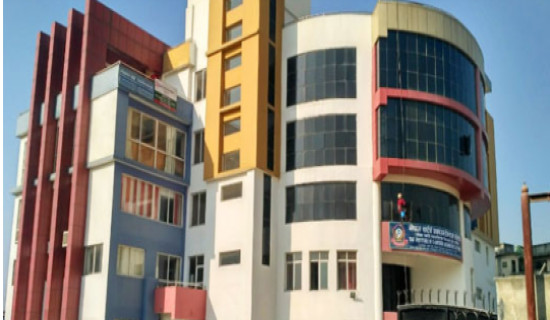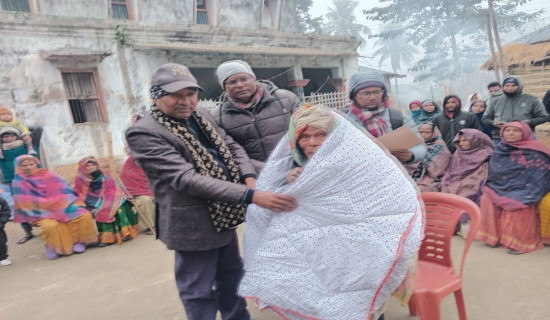- Thursday, 8 January 2026
A Novel About Social Transformation
Novelist Santosh Shrestha is a well-known music worker in the Nepali music industry. He is from Dang, Ghorahi, where he has observed social oppression over Tharus in the name of Kamalari and Kamaiya. He is an eyewitness to social conflict resulting from uneven access to the land of Tharus. While searching for ways to get rid of the bitter experience, he presents readers with a social novel on the social backwardness of the majority of Tharus and the unlimited enjoyment of natural resources by a handful of elites.
Faraina is the first novel of Shrestha, who, however, has over four dozen solo music albums and over 800 individual songs. Santosh, who has a Master’s degree in Nepali literature and informal music classes, has been able to tackle social and political issues in his first novel, Faraina.
The kamaiya and kamalari systems have existed in Nepal since time immemorial. Nepal ended its slavery system in 1925 AD, but another form of slavery still exists in the form of Kamalari and Kamaiya in Banke, Bardiya, Kailali, Kanchnpur, and Dand districts. The government freed the Kamaiya system as a result of the protest on July 17, 2000. In September 2008, the government abolished the Kamaiya system. Likewise, Nepal announced the end of the Kamalari system on June 28, 2013.
However, it could not bring about changes as expected by the government, as out of 18291 identified (20758 self-disclosures) Kamaiyas, many have not been able to get citizenship and land yet, turning them back into "landless".
Faraina tells the story of Tharus, who, for a long time, were not able to get citizenship in their own country due to social discrimination, ignorance, and the lack of an effective government.
Tharu’s livelihoods were impacted as they were bonded by indebtedness from generations, which reflects on their worrisome life expectancy.
The writer creates an actress named "Faraina’ with the social status of Kamalari, as bonded labour. Whereas her father, Ruplal, is a Kamaiya, a bonded male slave kept by an elite to get a loan paid back, taken by his forefathers. Faraina is a character from a socially and economically deprived family who appears as a revolutionary Kamalari. She achieved social and political status with her hardship, life experiences and groundbreaking personalities. She is able to hold prime ministerial and then presidential positions.
The novel presents worrisome social status of people due to the uneven distribution of natural resources, mainly fertile land. Due to a lack of land ownership, a large number of Tharus were forced to live with limited or no life opportunities. Access to land negatively impacts other indicators of Tharu’s social development.
The novel demonstrates the story of ‘landless peasant’ and the 'bourgeois. It is the story of Tharus, who produces food but sleeps with an empty stomach. It is a story of Tharu girls who print tattoos on their beautiful legs or arms not to beautify but to make themselves dreadful so that they can save themselves from being raped or abused. The novel is able to disclose the hardship of proletariat Tharus, who streamed themselves in social movement for political power.
The novel demonstrates significant changes in social development under the leadership of Faraina.
The novel represents a social transformation process of shifting power from elites to the deprived as a consequence of the voices raised by them against oppression imposed by elites. The novel demonstrates how Nepali women in the later period succeeded in achieving political positions at the local, provincial, and national levels.
Faraina is an optimistic novel that routes a school dropper Kalamari, to become a social as well as a political role model. It tells readers how a Tharu girl refused social ill-practice and turned herself and Tharu’s social status around.
The realisation of social needs and aspirations and the blocking of opportunities by power holders create fertile ground for social movement and leadership development. The novel demonstrates that the oppression over Tharus from generations created a playground where Faraina, Ruplal, Juganya, and Somlal appeared as players. Among many, Faraina establishes herself as a political figure.
The novel satirises power holders for not being able to address the aspirations of Nepali people. It provokes politicians to abolish all kinds of social taboos, which include Deuki, Jhuma, and Chhaupadi by implementing laws. The novel imagines a prosperous and peaceful Nepali society with the availability of employment in a corruption-free society.
If we see the novel from the perspective of social conflict, it is about social confrontation for power between peasants (Tharus) and elites (Landholder). These forms of conflict unfold in many ways in terms of sexual harassment and abuse, labour exploitation, and the capturing of Tharu's land. The oppression of elites pushes Tharus into a vicious cycle of poverty by immigrant landholders off the hill after the eradication of malaria in Terai. These people, known as 'invasive influxes,' wield power at the local level by influencing power centres. As a result, the Tharus have been drowning in debt for generations, although they are aboriginal people.
The first half of the novel tells conflicting stories among landholders and Tharus about their sorrowful life patterns. The elite impose their vested interests to obtain unpaid and bonded slaves. The elites capture land, abuse girls, and alienate them from education, health, and identity. Tharus realises that they have manipulated their own dignity. Ultimately, the barred opportunities help Tharus take part in political movements for rights and social transformation.
The extreme suppression reflects the fact that Tharushas has not been able to receive citizenship. The social confrontation appears in the form of Tharu’s obstructed access to education, health, land, and self-dignity, and most importantly, the protection of young girls from being abused. The novel demonstrates a wide spectrum of social conflict.
Although Faraina is a successful novel that captures social issues, it naturally leaves space for criticism. The entry of a social advocate (unnamed traveller) seems hypothetical. After the restoration of democracy, the constitution of Nepal allows people to enjoy fundamental rights. The traveller appears to be an actor who was prevented from doing so. The vandalism that destroys Faraina’s hut seems like something out of an action movie. The writer is biassed toward the Sharmas and Bahun, so he presents them as cruel elites or power holders who oppress Tharus. Non-Brahamin or even Dalit could have imposed their interests over Tharus, which is not imagined.
Likewise, social transformation is an unavoidable but slow process, and this is a fact that the writer ignores.
The novel communicates that the entire freed Kamaiya received citizenship and a land blueprint. However, this statement can be partially true.
The novelist seems to be in a rush to empower women with all power, including that of an executive. Nonetheless, the novel should inspire women to break social taboos, but in a patriarchal society like ours, delegation of power to deprived women from backward communities takes time. The novel demonstrates political, economic, and social transformation in a short period of time under Prime Minister Faraina, which is hardly sustainable. Faraina is granted several opportunities as she is from a backward community, which seems like a gesture of sympathy, but many Farainas deserve space on the policymaking platform.
(Dahal is a lyricist and researcher)

















